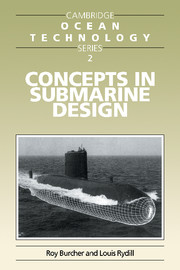Book contents
- Frontmatter
- Contents
- Introduction
- Acknowledgements
- 1 Design in general
- 2 Milestones in submarine history
- 3 Submarine hydrostatics
- 4 The weight/space relationship
- 5 Submarine structures
- 6 Powering of submarines
- 7 Geometric form and arrangements
- 8 Dynamics and control
- 9 Submarine systems
- 10 Considerations of building and costs in design
- 11 Generating a concept design
- Appendix 1 Hydrostatic conditions of flotation
- Appendix 2 Operational practice for keeping in trim
- Appendix 3 Assessing weight and size of variable ballast
- Appendix 4 Submarine pressure hull strength (Prediction of interframe collapse pressures)
- Appendix 5 Estimates of resistance and propulsion
- References and suggested reading
- Index
10 - Considerations of building and costs in design
Published online by Cambridge University Press: 05 July 2014
- Frontmatter
- Contents
- Introduction
- Acknowledgements
- 1 Design in general
- 2 Milestones in submarine history
- 3 Submarine hydrostatics
- 4 The weight/space relationship
- 5 Submarine structures
- 6 Powering of submarines
- 7 Geometric form and arrangements
- 8 Dynamics and control
- 9 Submarine systems
- 10 Considerations of building and costs in design
- 11 Generating a concept design
- Appendix 1 Hydrostatic conditions of flotation
- Appendix 2 Operational practice for keeping in trim
- Appendix 3 Assessing weight and size of variable ballast
- Appendix 4 Submarine pressure hull strength (Prediction of interframe collapse pressures)
- Appendix 5 Estimates of resistance and propulsion
- References and suggested reading
- Index
Summary
INTRODUCTION
10.1 Attention in previous chapters has been focused on the technical considerations in submarine design which bear on achieving the required performance. In the first chapter, however, we did point out that the designer has at all times to keep in mind that the submarine should be capable of being produced at an acceptable cost to the customer and be considered value for money, and also that the resources are available for the detailed design and build. Although it is conceivable that performance might be regarded as paramount, and consequently that any costs incurred either directly or to create the resources necessary for building have to be accepted, in most designs it is necessary to keep a strict balance between performance, cost and resources.
It is pertinent to consider the comparison between the cost of building a submarine and that of a corresponding commercial ship. On the basis of displacement tonnage there is a considerable difference in cost per tonne for the two types of vessel. The difference between the two calls for explanation.
One factor is the difference in the way in which the size of a submarine and a commercial ship is expressed. The gross tonnage of a commercial ship is in fact determined by its cargo or hold space and does not involve the weight of the ship itself. It is better to compare costs on the basis of the actual weight of the ship as constructed, termed its lightweight. Making that change, the cost per tonne for a commercial ship is higher but still significantly less than that of a submarine.
Information
- Type
- Chapter
- Information
- Concepts in Submarine Design , pp. 225 - 240Publisher: Cambridge University PressPrint publication year: 1994
